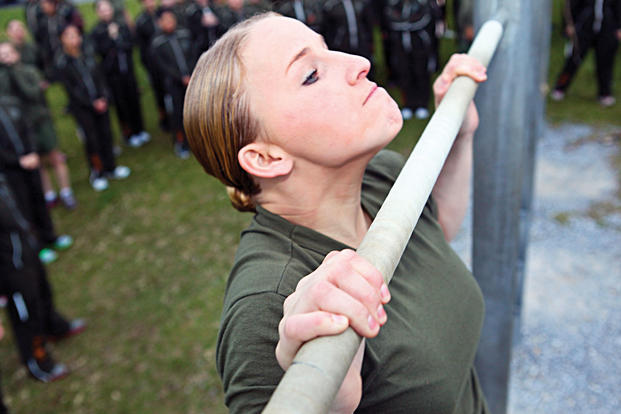MARINE CORPS BASE QUANTICO, Va. -- More female Marines chose pull-ups on their physical fitness test in 2018 than did last year, but about a third of all women still opted for the alternative exercise on the upper-body strength portion of their annual exam.
Nearly two years after the flexed-arm hang was axed from the Marine Corps' PFT, about 30 percent of female Marines chose to do pushups in place of pull-ups in 2018. Less than 3 percent of male Marines chose pushups instead of pull-ups this year.
The number of female Marines opting out of pull-ups is down from 35 percent in 2017, though, and the head of the Marine Corps' Force Fitness Division expects the number will continue shrinking.
"It's not an easy test -- it's the hardest one of all the services," Col. Stephen Armes told Military.com. "... But female Marines are disproving the [idea that they can't do pull-ups] on a pretty regular scale."
Of the nearly 10,000 women who did perform pull-ups on their 2018 PFT, many are exceeding the number required to get full marks, Armes said. More than a third of those female Marines busted out nine or more on the test.
Women under 45 need between six to 10 pull-ups -- depending on their age -- to earn full marks.
No Marine can achieve a maximum PFT score without choosing pull-ups in the new system. Opting out of pull-ups also makes it more difficult to achieve a first-class score, the highest level.
The requirement for women to choose between pull-ups and pushups was just one change in the biggest overhaul of the service's physical fitness test in decades. Scoring got tougher across-the-board when the changes went into effect on Jan. 1, 2017. That has led to more failures and fewer first- and second-class scores.
"It's pretty much tracking where we expected," Armes said. "Our target has always been about a 70-20-9 percent split from first, second and third class. In 2016, we were way above that."
Before the event and scoring changes, 84 percent of Marines were earning first-class PFTs. That number has now dropped down to about 70 percent.
Now, more Marines' scores are falling in the second- and third-class buckets. Nearly 20 percent of Marines earned a second-class PFT score this year, up from about 13 percent in 2009. More than 7 percent got a third-class score this year, up from just about 1 percent two years ago.
Failure rates are also up, which Armes attributes to new Marine Force Fitness Instructors -- noncommissioned officers with special skills who help improve a unit's physical training and nutrition regimens.
They're enforcing testing standards, Armes added. It might not be easy to cheat on your PFT run time, he said, but Marines might have been dropping their arms too low on their crunches or kipping their legs to help them get more pull-ups.
Now, Marines are being dinged for that, he said. This year, 2.2 percent of Marines failed their PFT, up slightly from 1.9 percent last year.
Since any Marine who chooses to do pushups in place of pull-ups can earn a maximum of only 270 out of 300 on the test, Armes urges all leathernecks to keep working toward the pull-ups.
"I'm glad to see more males and females doing pull-ups -- that's a good trend," he said. "It's going to get them to that 300 points, and it's the harder [exercise]."
-- Gina Harkins can be reached at gina.harkins@military.com. Follow her on Twitter at @ginaaharkins.












